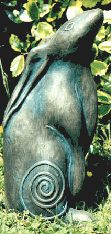
Image: Subject and photographer unknown.

 Despite their reputation for rapid increase and hyper-sexuality, hares are not especially prolific breeders compared to rabbits – much less so compared to rodents. . . . But the brown hare does exhibit one extraordinary reproductive capacity which has provided, in the exaggerated descriptions given of it from Aristotle onwards, the basis for its reputation for unique and almost preternatural sexual proclivities and increase.
Despite their reputation for rapid increase and hyper-sexuality, hares are not especially prolific breeders compared to rabbits – much less so compared to rodents. . . . But the brown hare does exhibit one extraordinary reproductive capacity which has provided, in the exaggerated descriptions given of it from Aristotle onwards, the basis for its reputation for unique and almost preternatural sexual proclivities and increase.
 Arabian hares have exceptionally long ears and pale, almost bleached coats which serve as effective camouflage for their life in the desert.
Arabian hares have exceptionally long ears and pale, almost bleached coats which serve as effective camouflage for their life in the desert.


 Despite widespread beliefs that the sight of a hare was a bad omen, in a few parts of Britain hares were thought to bring good luck. Some regions held that if a hare was encountered then a wish could be made as soon as it had passed by. To see a black one was a sign of good fortune, although a white one brought bad luck.
Despite widespread beliefs that the sight of a hare was a bad omen, in a few parts of Britain hares were thought to bring good luck. Some regions held that if a hare was encountered then a wish could be made as soon as it had passed by. To see a black one was a sign of good fortune, although a white one brought bad luck.

 Wherever Hadrian might travel,
Wherever Hadrian might travel, 
Blandine Anderson’s painted works employ both Acrylics and Oil-paint. More recently, she has favoured heavily textured oil paint, built up in thick layers, which is combed, scratched and scumbled - to echo the textural qualities found in her ceramic works.
As in her recent ceramics, these paintings explore Blandine’s interest in natural forms and are often initially inspired by seeds and leaves. From this starting point, similar shapes from other sources are assimilated. These may be plants, bones, the bodies of living creatures, a piece of circuitry from an electrical appliance, the contours of a map, or the shape of a field. The shapes become intermingled and abstracted in the sketch-book, so that what begins as a seed may very easily become a bird.
The resulting images are not intended to be illusory – they explore the qualities of paint on the surface of the canvas. They are merely evocative of recognizable shapes or subjects. For this reason they are usually un-framed – painted on deep-edged canvasses, which emphasize their actuality.

Due to their relatively exposed way of living hares have an unusually high number of predators, with high mortality rates among their young. Adult hares live on average no more than one year, compared to a potential lifespan of up to twelve years. There is an epigram by Ausonius in which a hare hunted to the seashore by dogs and men cries out, before being eaten by a dog-fish, that "all rape of land and sea is on me/ even of the heavens, if there is a dog-star." An ironic conclusion, since in the southern night sky there is both a "dog-star" and a "lepus" constellation at the foot of the hunter Orian.



 See also the previous posts:
See also the previous posts:
Jackrabbits are actually hares, not rabbits. Hares are larger than rabbits, and they typically have taller hind legs and longer ears. Jackrabbits were named for their ears, which initially caused some people to refer to them as "jackass rabbits." The writer Mark Twain brought this name to fame by using it in his book of western adventure, Roughing It. The name was later shortened to jackrabbit.
There are five species of jackrabbits, all found in central and western North America. They are speedy animals capable of reaching 40 miles (64 kilometers) an hour, and their powerful hind legs can propel them on leaps of more than ten feet (three meters). They use these leaps and a zigzag running style to evade their many predators.

The hare is an extraordinary and ancient archetype which is important to many different cultures and inspires countless artists today. In many mythic traditions, the hare is a lunar animal associated with femininity, longevity and rebirth. Look a little deeper and you find that the hare is a paradoxical creature symbolising both foolishness and intelligence, lust and purity, witchcraft and Christianity.








NOTE: I've had reports of readers not being able to access this blog and/or pages of it because they get stuck on the “Sensitive Content” warning page which redirects back to itself every time they try to click through. I'm not sure what the issue is, though it might be a problem stemming from when the site shifted from http to https. Accordingly, it should be resolved when you add https:// to the front of the link for the page you are trying to access.